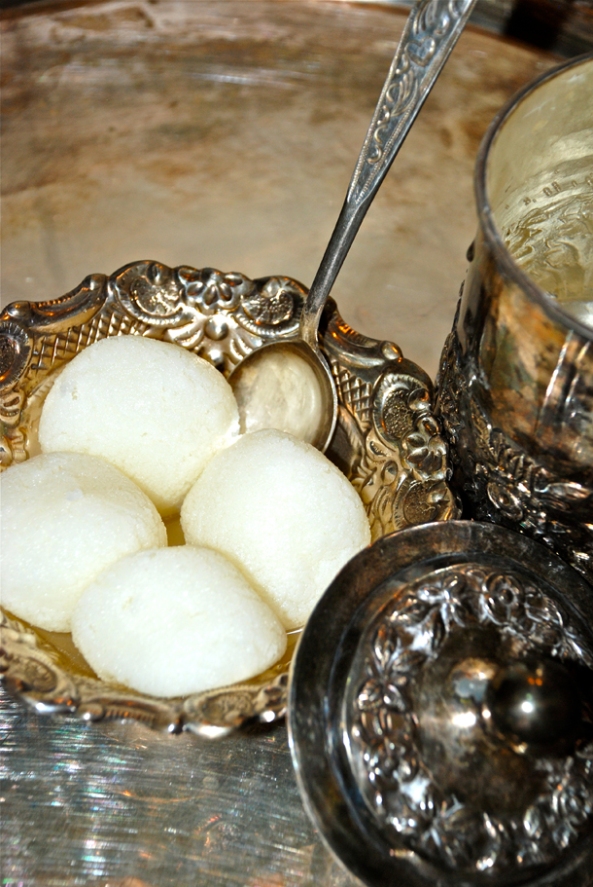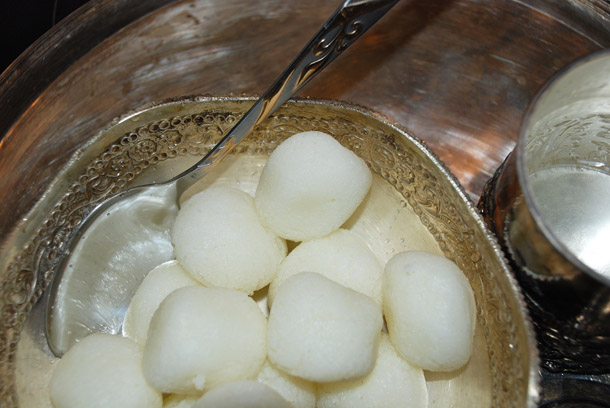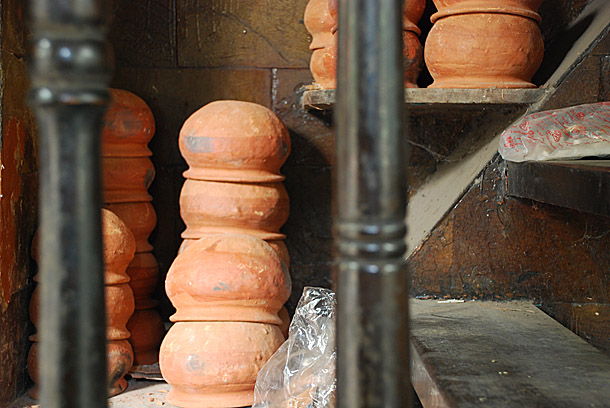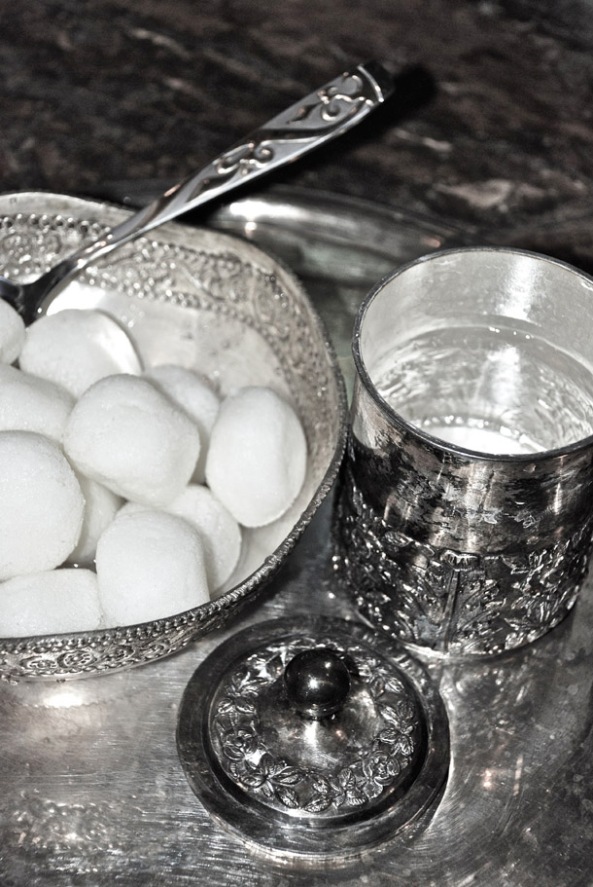
We are just 2 days into the Bengali New Year and what better excuse can there be than this to share a bit of Bangaliana (everything Bengali) with everyone – the ones who are already familiar with Bengali culture and tradition and also those who are absolutely uninitiated to it. But where to start and how to start? When you grow up amidst a certain culture it becomes so much a part of you that it is not very easy to dissect oneself from it and write about it, specially if the intention is to introduce that culture to the world. But nothing is impossible. One just has to make a decent start. Should I write about a traditional Bengali recipe? That might be a first in my blog as I have been writing a lot on Bengali Fusion Food that doles out from our kitchen. Or should it be a nostalgia from childhood? Or perhaps it could be some sweet talk about a Bengali Sweet since Bengalis are synonymous with Sweets.
I decided to settle on the latter but on a more controversial note. Rasgulla or Rôshogolla (as is pronounced in Bengali) is perhaps the most famous of Bengali Sweets but would Bengal fall apart if I were to say that the Rôshogolla doesn’t even belong to Bengalis and has been imported? So is Chhana or the Indian cottage cheese with which these quintessential Bengali Rôshogollas are so proudly made up of! It definitely would but that should not take away the entire ‘sweet’ glory away from Bengal.
Behind the story
Mishti or Sweets are officially designated to ‘belong’ to Bengalis. Bengali Sweets are synonymous to having ISO Certicficates in Indian Sweets! Hence, you will find many famous Indian sweet shops outside Bengal with a ‘Bengali Sweet’ Counter or a banner outside the Sweet-shop claiming that ‘BENGALI SWEETS AVAILABLE HERE!’
Sweets are a necessary sign-off for a traditional Bengali meal. You end your meal with Chutney (Chutney is a sweet, tangy paste and can be made with every conceivable fruit and even vegetables! For example – Aam/mangoes, Jalpai/Olives, tomatoes, Anarosh/pineapple, Tetul/tamarind, Pépé/papaya and various other type of fruits. Dry fruits like Khejur/dates, Kishmish/raisins may also be added to it. While cooking Chutneys are splashed with Phoron/Mustard seeds cooked slightly in oil or Paanch-Phoron/5 seeds cooked in oil. Papad/Big chips like flakes made up of Potatos or Dried Daal usually accompanies the Chutney). After the Chutney comes the formal dessert tasting! The choice in Mishti/Sweets is absolutely endless. This is a category that has catapulted Bengal into a different quotient of sweetness. Mishti Doi/ Sweet yoghurt, Bhapa Doi/Steamed Yoghurt, Payesh/ Sweet dessert made with rice, milk and sugar, Rasamalai, Pantua, Lyangcha, Chamcham, Chanar Jilipi, Rajbhog, Rasakadambo…
And then there is THE Rôshogolla!
Rôshogolla defines a Bengali character as well as Bengali talent. Bengalis are supposed to possess sweet voices and they sing well – yes, you guessed it right – probably because of Rôshogolla! Evidence indeed suggests that most of the greatest singers and composers in the Indian music industry specially the Hindi film industry are all Bengalis starting from the legendary Kishore Kumar, RD Burman, Salil Chowdhury, Manna De to today’s singers like Kumar Shaanu, Abhijit, Shaan, Shreya Ghoshal, Monali Thakur and many others. The Bengali language is very soft and flexible, again you guessed it right – because of Rôshogolla! Half a million Bengali girls have nicknames like Mishti, Mithi, Mithu etc and all these are Bengali terms meaning Sweets or Sweetness. In-fact Bengalis are supposed to possess round faces, that too because of our association with Rôshogolla and not the Mongoloid connection!
The history of Rôshogolla:
Rôshogolla is a Bengali’s most famous culinary weapon. Unfortunately this famous sweet didn’t even originate in Bengal. Rôshogolla originated in the Indian state of Orissa, a neighboring state of Bengal where it is pronounced as Rasagola. They are made from balls of Chhana (an Indian cottage cheese) and semolina dough, cooked in a sugar syrup. And the variations of Rôshogolla is also unique and popular. Now, Rôshogollas have become popular throughout India and other parts of South Asia.
In Orissa, Rôshogollas, also known by its original name, Khira mōhana has been a traditional Oriya dish for centuries. The inventors of Rôshogollas are thought to be the Kar brothers, the descendants of a local confectioner, Bikalananda Kar, in the town of Salepur, near Cuttack. Even today these Rasgullas famously named as Bikali Kar Rasgulla, are sold all over Orissa. Many variants of these Rasgulla are available and are popular in many parts of Orissa.
In the middle of the nineteenth century, Bengali cuisine borrowed heavily from Oriya culinary traditions and the popularity of Rasgulla spread to the neighboring state of Bengal. A sweet seller named Haradhan Moira may have introduced the dish to Bengal. In the year 1868, Nobin Chandra Das, a local confectioner of Kolkata, simplified the recipe to make sponge Rasgullas. His son, K.C. Das started canning the product and made the Rôshogolla the biggest Bengali export to the world. Today, several other Indian sweet makers from places such as Bikaner and Delhi as well as manufacturers such as Haldiram’s have started manufacturing canned Rôshogollas. More recently, it has been marketed by the Kar brothers as well. In Nepal too the Rasgulla is popular under the name Rasbari. (The History of Rôshogolla – Source Courtesy: Wikipedia)


Though canned Rôshogollas are probably the only choice for many Rôshogolla-desirers outside Bengal or India, traditionally they are sold in clay pots called handis. The above photograph of mine is from a very famous sweet shop in Kolkata where how the handis are stacked is equally important as the making of the Rôshogollas!
There are lots of famous sweet shops in Kolkata and each Sweet Shop is famous for it’s own signature sweet. But sometimes our emotions are stuck with one little sweet-shop in the neighborhood. My emotions are similarly stuck with a small sweet shop called ‘Maity Sweets’ tucked in a corner around the market area – Ghugudanga Bazaar by the Repose Clinic off the ubér-posh Ballygunge locality and Ironside Road. Here the Rôshogollas are mini-sized and super-soft, priced at INR 1/piece and the rates haven’t changed since the last 15 years! Every guest at our home has fond memories of Maity-r ek-takar Rôshogolla (meaning Maity’s Rôshogollas that are priced at INR 1!)
My very good friend, Srikanth is a connoisseur in Bengali Sweets and everything that goes into Bengali cooking. Though he’s born a Tamilian, he has probably more knowledge on Bengalis and Bengal than any of us Bengalis. Currently he’s on his way to open his third store in Bangalore which sells traditional Bengali Sweets. And Bangalore is not even next door to Kolkata. Tucked away in the South-Indian state of Karnataka, it is approximately 1920 kms away from Kolkata! I have had to revise my original post after receiving a ‘sweet’ email containing various minute details about Rôshogolla. So here’s the revised post as an ode to my Tamil friend who’s now turned completely Bong (the ubér-cool term for a Bengali)!
Variations of Rôshogolla
Rôshogolla variants come under the Genre ‘Rokom‘ which is made from Cow’s Milk and is made of pure Chhanna:
– Notun Gurer Rôshogolla are the seasonal variations of Rôshogolla with addition of Notun Gur or Season Fresh Jaggery during the winter season thereby producing beige-coloured Rôshogollas. This is a gastronomical experience that probably cannot be translated into words.
Types of Rôshogolla
– Khasta ie crunchy
– Odisha type Khasta ie crunchy like in Orissa where they also add Suji/Semolina
– Sponge
– Half Sponge
Derivatives of Rôshogolla
These may consist of ‘Bhaja Misthi’ or Sweets that have been fried and are made up of Channa, Kheer/khowa and Maida/White Flour.
– Pantua consists of chhana balls deep fried in oil before being soaked in syrup – this is a Bengali version of the well known Gulabjamun
– Lyangcha is also similar to Pantua but has an elongated shape (the Z-SISTERS call these sweet sausages!)
– Malai chop, consists of prepared chhana that is sandwiched between a layer of sweetened clotted cream
– Rasmalai consists of Rôshogollas where the sugar syrup is replaced with sweetened milk.
– Kamalabhog mixes orange extract with chhana and produces big orange-coloured Rôshogollas smelling of fresh oranges.
Importance of Chhana
Chhana is fresh, unripened curd cheese widely used in India and Bangladesh and is a crumbly and moist form of Paneer (Indian Cottage Cheese or farmer cheese or curd cheese made by curdling heated milk with lemon juice, vinegar, or any other food acids). This Cutting of the Milk to make Chhanna ie Acidification is the most important factor affecting the quality of Rôshogolla. Chhana is created in a similar process to Paneer except that it is not pressed for as long. Though the Paneer can be traced back to the Vedas dating back to 3000 BC and has an Indian origin, Chhana that is the base for most of the Bengali Sweets has been imported from Portugal and can be traced back to the Portugese settlements in Bengal during the 16th Century AD.
Important Factors Affecting the Quality of Rôshogolla
– The Cutting of the Milk to make Chhanna ie Acidification is the most important factor affecting the quality of Rôshogolla
– Rosh or Chasni ie the thickness or BRIX of Sugar Syrup
– The temperature and the way the medium ie the previous day’s whey water, vinegar, lime is introduced to cut the milk (the best results are produced when you slowly introduce the acid medium into the milk)
There is a superb conversation going on here regarding the making of Rôshogollas. It is a definite read for those who are attempting to make Rôshogolla at home.
A Nostalgic association
My maternal grandmother comes from Bhatpara, which is a suburban town and a municipality under North 24 Parganas, a district in the state of Bengal, India. It is situated on the bank of Ganges or the Hooghly river. Bhatpara is known for its rich traditions and renowned for its Sanskrit cultural heritage and learning. There are a number of sweet shops in Bhatpara and the residents and the descendents with any association with this place is famous for their sweet tooth. Rôshogollas here are coated with actual sugar particles – taking the intensity of the Bengali sweetness to a different category!
It is not unusual that my beloved Dida or my maternal grandmother was an expert in making sweets – and sweet pickles. She made elaborate and artistic Bengali Sweets which looked and tasted equally awesome. The laborious process in making these took most of her days and probably night too. We would wait to see what sweets she had specially prepared for us. To make a serious issue lighter, it is also not unusual that she took Insulin injections till her very last day along with one Rôshogolla that followed her meals!
The traditional importance of Rôshogolla
In the coastal city of Puri in Orissa, the Rasgulla has been the traditional offering to the Hindu goddess, Lakshmi (the Hindu Goddess of Wealth), the consort to the Puri temple’s main deity, Jagannath. In fact, it is an age-old custom inside the temple to offer Rasgullas to Lakshmi in order to appease her wrath for being ignored, on the last day of the eleven day long famous Rath Yatra (chariot festival). Only after the goddess has savored Rasgullas, do the trinity of deities re-enter the temple precincts after their sojourn. Rasgullas are distributed to the numerous devotees who throng to witness the event. This intricate ritual, called Niladri Vijay, has traditionally marked the commencement of the festival every year.Scholars believe that the sweet may in fact owe its origin to the very temple itself claiming that the Rasgulla might be more than 600 years old and is as old as the Rath Yatra in Puri! The Rath Yatra, which started more than six centuries ago, has not changed with times. And until today, Rasgulla is the only sweet offered to Mahalaxmi, Jagannath’s consort, to appease her when the deities return home. Traditional Oriya folklore likens even Lord Jagannath’s round eyes to Rasgullas. It has been suggested that Bengali visitors to Puri might have carried the recipe for Rasgulla back to Bengal in the nineteenth century. (The traditional importance of Rôshogolla – Source Courtesy: Wikipedia)
Serving of Rôshogolla
Though Rôshogollas are usually served at room temperature, nowadays various experiments have led them to be served chilled. Or sizzling hot when they have just been freshly prepared. Or even frozen to make Icecreams Rasgullas – notable among them are Notun Gurer Rôshogolla Icecream from the popular Bengali restaurant 6 Ballygunge Place (in Kolkata as well as in Bangalore). You could also enjoy a very easy preparation, an experiment from our very own kitchen – Icecream Rasgulla with Blueberry Sauce!
Even though the knowledge that both Rôshogolla and the Chhana does not solely belong to the Bengalis and have been imported, can be really heart-wrenching, it can’t take away the entire legacy of Bengal in sweet-making. Rôshogollas will eternally belong to the Bengalis. And with that sweet note, here’s wishing everyone happiness, health, wealth & prosperity on the occasion of the Bengali New Year.
Unblogging it all… Ishita

Links to more images of my photographic journey into the discovery of Rôshogolla and other Bengali Sweets.
Following articles will introduce you to Bengali Food or Kolkata (the way I see it and feel it!):
Through Food:
Traditional Bengali Cuisine – An etymological explanation of our food-fetish
Bengali Sweets That Came By Parcel! – Gujia, Jibe Goja, Abaar Khabo & Jolbhora
Easter Egg Curry – Recipe; Bengali Fusion, Traditional Bengali plus Continental
Mashed Potato Bengali Style/ Aloo Bhaaté – Recipe; Bengali Fusion
Yoghurt Aubergine with Pomegranate – Recipe; Bengali Fusion
Purple Haze Yoghurt with Purple M&Ms – Recipe; Bengali Fusion
Icecream Rasgulla with Blueberry Sauce – Recipe; Bengali Fusion
Through Writing:
Terraces and Beyond
Living by the water with sunset as prop – Kolkata & the Ganges
Magistrate’s House, No 1 Thackeray Road, Alipore
Auto, my ultmate road crush – Kolkata
The unlikely twins – Oberammergau & Kolkata
Relates articles over the web:
– Paneer
– Chhana
– Use of Cottage Cheese in Bengali Sweets
– The Portugese Settlements in Bengal


Anek kichu sheeklam! I’m so much smarter now. You’ve inspired me to try and make some. Maybe I should wait until Ma visits, otherwise I’m bound to make stupid mistakes!
LikeLike
Thanks! You call yourself a Desi Chick and yet scared of making mistakes? If there are mistakes then say that the dish was supposed to have tasted exactly like that!!!
LikeLike
hahaha! Trust me, I’ve made some doozeys in my time. I don’t mind making mistakes but getting back lost time….now that tics me off!
LikeLike
Once I had made Mango souffle – which my friends thought was mango ice-cream. The next day the same recipe became mango custard – everybody took the same recipe from me – But I still haven’t told them it was originally supposed to be mango soufflé!!!
LikeLike
Thank you for this Ishita! These look fabulous!
LikeLike
They are delicious to taste too – but might not be so easily available for you (the canned ones yes, but maybe not the fresh ones made in a traditional sweet shop!)
LikeLike
These sweets look so lovely, Ishita! I’m pretty curious of its taste. 😉
LikeLike
Are you based in Amsterdam? I believe there are Indian/Bangladeshi supermarkets there – you could get probably get canned Rasgullas there… let me ask a few friends based there and will let you know.
LikeLike
Thanks a lot, Ishita. 😉
LikeLike
Pingback: Bengali Sweets That Came By Parcel! «
Pingback: Business Man | Grooooovey Moooovie
Pingback: Business Man « Festival Films Review
ishita, my mouth’s watering now! freak m hungry for sweets even at this hour of the night! I am a complete bong in this matter! awsmmm photography btw! 🙂
LikeLike
You awake Ashmita? Sorry don’t want to sound like a guardian – good for me coz nostalgia generally stirs up when it’s late. Thanks for the compliment – so you think we could entice the big world of Non-Bongs with Bong sweets? That’s my objective really – hence so much of importance on Bengali Fusion Food!
LikeLike
well i guess with more bong writers we could certainly entice the big world of non-bongs with bong sweets! and about the first question on your reply! YES! i am awake still! m a night person! can sleep all day but cnt blink an eye in the night! i gues the flow of more creativity comes to me at night! 😛
LikeLike
Well I should have guessed – I’m doing the same – though the time is 1 and a half hours behind – so not as late as yours! Look forward to crossing each other on our blog-paths:)
LikeLike
Pingback: Business Man « Studio City Films
Pingback: Icecream Rasgulla with Blueberry Sauce «
Pingback: Business Man | Island Movies Review
Pingback: Flying over Mt Everest – Nepal «
I had these at a family friends wedding last year. Her father and my step father were in the Pakistani army before the 1971 divide. They are from Bangladesh. I have to say it is the best desi sweet I have had, EVER!!!
LikeLike
They have a very unique taste I think. Like any other regional food one has to get used to that I guess… for me it stirs up huge nostalgia though very good Rasgullas are available here in Chappan Bhog as well. To be honest Chappan Bhog is really good.
LikeLike
Pingback: Rasgulla Macapuno – When a Filipina Turns Bong! «
Pingback: Dalma (Odisa Niwas, Chanakyapuri, New Delhi) « yummraj
Pingback: Notun Gurer Payesh/Rice Pudding & Remembering Dida «
Pingback: Authentic Bengali Cuisine… In ‘Slight’ Details «
Pingback: Gulab Jamun Rabri «
Pingback: Rasgulla Macapuno On TV & Shubho Bijoya to all! «
Pingback: Living By The Water With Sunset As Prop – Kolkata & the Ganges «
Pingback: Semaiya Kheer/Vermicelli Pudding, Eid in Dubai… Eid Mubarak! «
Pingback: Gajorer Payesh/Carrot Pudding… Wishing Everyone A Happy Diwali! «
Pingback: Shondesh/Sandesh Pudding… Guest Post For Sudeshna From Cook Like A Bong! «
well i own a Bengali sweet shop in Mumbai and have kept the traditional recipies for making our sweets..if u wud like we could have them sent over if Ur ever in Mumbai or somebody travelling..have a whole lot of Korean,Chinese,other Asian and american friends who regularly take sweets back and i havent heard of any comlpaints…check out our facebook page https://www.facebook.com/sweetbengal.malad or feel free to call 9819876127
LikeLike
Hi Anirudh… here’s wishing you a fabulous New Year. Apologies for noticing your comment a bit too late but never the less it’s good that all the sweet talk began in the New Year. My friends who are living in Mumbai are aware of a shop called Sweet Bengal. Is it the same shop? The link you have provided is not working though. Infact we got some notun gurer shondesh from Sweet Bengal the other day… Do get back. You can check the pics here… https://www.facebook.com/media/set/?set=a.504216942945068.119186.203730419660390&type=1&l=a5ea35228d
LikeLike
Pingback: Shorshe Bata Maach – Mustard Salmon In This Case | A Detour From Thailand To Wish Shubho Noboborsho! |
I had the Jaggery rasgulla for the first time in India a few months ago, and I must say I’ve never tasted anything like it before! One of my favourite Indian sweets now 🙂
LikeLike
Nice! Love the sweet and good to be enlightened now on its origins.
LikeLike
Aditi… so now you know that what you were ogling at last night is Odhissi and not Bengali!!! Thank you very much for hopping in:)
LikeLike
Ahhh… great. Nolen gurer roshogolla! You even have nolen gurer icecream, you know that? Tempting you even more. Ritu, your instagram pics on India is absolutely a treat. Great going… good wishes!
LikeLike
Pingback: Poila Baishakh with Shiraz | Celebrating Festivals in Dubai – Episode 4 |
LIES, DAMN LIES & NOBIN DAS!
According to the K. C. Das website itself, friends of this supposed culinary Einstein advised him to patent his famous creation, the rasgulla.
According the website:
“Contrary to the advice of his friends and admirers to take out patents, he taught the intricacies of Rossogolla-making to numerous sweetmeat makers.”
Except that there was no patent law in India those days! The first ever legislation to protect intellectual property law had just been introduced in India! It was Act VI of 1856 on Protection of Inventions. It granted “exclusive privileges” to the inventor. The legislation was designed only to safeguard British colonial interests. Not surprisingly, the first petition was filed by an Englishman – a certain civil engineer by the name of George Alfred DePenning for his invention, “An Efficient Punkah Pulling Machine”.
The first real patent law enacted in India was the Indian Patents and Designs Act 1911. Even this law was to safeguard British colonial interests and not designed to protect Indian inventors. This led to the Indian Patents Act of 1970: the first patent law designed to protect the likes of Indian inventors such as Nobin Das, which was over a century since he masqueraded as the creator of the rasgulla.
To claim that way back in 1858, Nobin Das & Co. thought about patenting the rasgulla proves that the entire story is a load of PURE, UNADULTERATED BULLCRAP!
LikeLike
Thank you for leaving your comment. But I haven’t written anything about patenting the Roshogolla!
LikeLike
Yup, but you mentioned Nobin Das. The fraudster that he was, I thought I’d add some more information.
LikeLike
Well Nobin Das only wanted to patent his creation of ‘white spongy rasgulla’.He never wanted to patent the original rasgulla of Odisha and nor did he claimed credit for inventing the original Odiya rasgula.. He only claimed that the white spongy rasgulla was his own creation… I think many people often confuse his invention of ‘white spongy rasogulla’ as the invention of the ‘original rasgula of Puri’ maybe because of the fact that in popularity, it is the white spongy rasgulla that is famous worldwide and has become synonymous with the ‘rasgula’. It is indeed sad that due to the over popularity of the white spongy rasgula, other variations of rasgula, including the original Puri one, remain largely under appreciated.
LikeLike
Didn’t realise that Punjabi Munda knew so much about Bengali Rasgullas! Jokes apart, I know what you are saying is true. Couldn’t find your blog url.
LikeLike
It’s impossible for another person to come up entirely from scratch, an identical recipe, down to the shape and size of the sweet, at a time when chhena was unknown to Bengalis, and miraculously, also come up with an identical name “rasagolla”. Clearly it is a case of unethical plagiarism.
LikeLike
Pingback: An Evening of Traditional Marwari Food | Daal Baati Churma |
Pingback: Opening Up My Bengali Kitchen For Dima Sharif | #RamadanSpecial2014 |
Pingback: Bhapa Mishti Doi and A Food Safari of Bengal in BBC GoodFood Middle East | Shubho Bijoya & Eid Mubarak! |
There are so many names of Rasagola, these are Rasagola, Rasagolla, Rasgola, Rasgolla, Rasgula, Rasgulla, Roshogola, Roshogolla, Rosogola, Rosogolla. In Odia ‘Rasa’ means Juice ‘Gola’ means Store. So Rasagola are the pure Odia village words. Rasgolla are prepared in different colours and different ways in Odisha. When anybody has to go their relatives home, taking of Rasagola is must with them. Each and every Odia family have the idea of preparing Rasagola in their own way, hence the method of preparation of Rasagola is imbibed in each Odia’s mind. In some festivals when Odia people are worshiping, they are using Rasgolla as Prasad from the old ancient age. At the time of Niladribije during Car Festival, Lord Jagannath had offered Rasagola to Goddes Laxmi for convincing her to move to Sri Mandir, which is a very old tradition (more than 900 years old). Most of the villagers of Pahala village near Bhubaneswar in Cuttuck-Bhubaneswar road are professional Rasagola business men from the last few decades, which were the Rasagola makers in the last few centuries. In Odisha, from a small footpath tiffin center to large five-star hotels you find Rasagola everywhere. People of Odisha enjoy their happiness by distributing Rasgolla to their neighbors and relatives after getting success in any occasion. During British ruling period, Odia people were going to old Calcutta and were engaged as cooks, because Calcutta was one of the business center of India at that time. Bengali people might have got the idea of preparing Rasgolla from the Odia cooks. So there are so many proofs and evidences behind the origin of Rasgolla form Odisha. Now a days some cleaver people are trying to theft the ancient cultural heritage of Odisha i.e. delicious cuisine of Odisha ‘Rasogola’. Hence Odisha Govt. should make patents on their own delicious recipes i.e. Rasagola, Chenapoda, Dalma etc., otherwise the cheats may theft these recipes as their own.
LikeLike
Hmmm too much copyright issues with the Roshogolla!
LikeLike
Pingback: Food, Love And Good Memories Travelling in My Suitcase! | IshitaUnblogged
West Bengal has decided to back down from its original claim that Nobin Das invented the rasgulla. It now states that it wants a GI tag for only the Banglar rasogolla and has clarified that it has no conflict with Odisha. This comes after the Odisha government compiled 130 pages of historical evidence that the sweet was being prepared in the kitchens of the Puri temple for at least 600 years. As it stands now: RASAGOLLA ORIGINATED IN ODISHA!
LikeLike
Pingback: Maple Roshogolla in an instant pot and GI status
Pingback: Malaikari – A Story of A Hidden Sweet Near Kolkata – Hangla Canvas